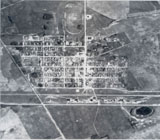Town Layout
The railway company would first establish numbered sidings, and those sited in an area of potential growth would be made stations, the nuclei of towns.4 Division points, established from 125 to 135 miles apart, to service the operational needs of the railway would support a larger town. Simply stated, “a railroad town was a component of corporate ambitions to manipulate people and resources, to command space and consolidate position, in order to maximize profits for the company.”5 The establishment of townsites “was to promote and control business along the line.”6
The need for well-planned townsites was recognized in 1850 when Alexander Doull stated that “some well considered plan for the arrangement of streets, drainage, the position of the public buildings, factories and workshops in connection with the railway and station buildings… should be acted upon.”7 Sandford Fleming, in his 1877 report on the Canadian Pacific Railway, included a village and town plan with instructions about siting.8 Formal platting had become accepted practice and “the grid was the simplest, cheapest and most rapid way of exploiting the land.” 9
Holtz, in her study Small Town Alberta, describes six town forms principally used by the railway companies in Alberta.10 Of the three major companies only the Grand Trunk Pacific had a comprehensive policy with regard to townsite development. Site and situation were important in the location of towns, and once platted to a standard plan, zoning and building restrictions were applied.11 With no clear policy for town layout, the Canadian Pacific largely depended on individual surveyors to establish a plan.12 Surveyors of the Canadian Northern had little impact on town design, merely laying out a plan previously adopted by the company, which had a preference for the “I” plan.13
The narrow range of options led to the feeling that “Prairie towns all look alike: identical grain elevators, identical banks, identical railway stations, a main street that is called Main Street and a road along the tracks called Railway Avenue—when you’ve seen one, as they say, you’ve seen ‘em all…. The towns do not reflect the people who live in them but rather the repetition of technology.”14 Monopolistic in their practices in town development, the railway companies imposed standardization and stasis. Too many towns, each performing “essentially the same function, that of funnelling traffic to the railroad”15 was a prescription for failure. As Holtz concludes, “Railway companies operating in Alberta were aware of the built-in obsolescence… but chose to ignore the problem.”16
Notes | Bibliography | Abbreviations
1. A. Holtz, “Small Town Alberta: A Geographical Study of the Development of Urban Form” (Thesis, Dept. of Geography, University of Alberta), 1987.2. J. Hudson, “Towns of the Western Railroads,” Great Plains Quarterly 2, no. 1 (Winter 1982).
3. C.W. Bohi, Canadian National’s Western Depots (Don Mills: A Railfare Book, 1977).
4. Holtz, p. 49.
5. Hudson, p. 42.
6. Ibid., p. 43.
7. A. Doull, “Report and Outline of a plan by which an extensive railway may be constructed in the British North American Colonies” (London: Canadian Land and Railway Association, 1850).
8. S. Fleming, “Report on Surveys and Preliminary Operations on the Canadian Pacific Railway up to January 1877” (Ottawa: MacLean and Roger Company, 1877).
9. Holtz, p. 27.
10. Ibid., p. 88.
11. Railway and Marine World, June 1908, pp. 415, 417.
12. Holtz, p. 92.
13. Ibid., p. 93.
14. H. Roberston, Grass Roots (Toronto: James Lewis and Samuel, 1973).
15. Hudson, p. 52.
16. Holtz, p. 131.


